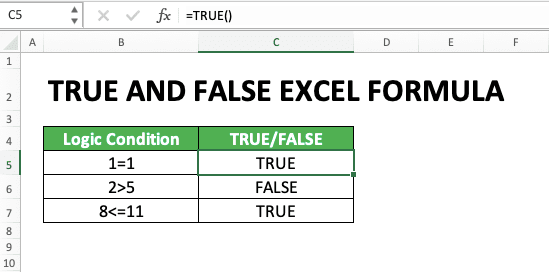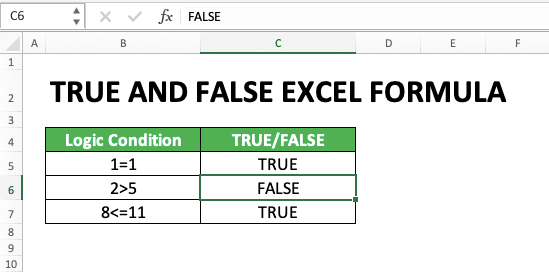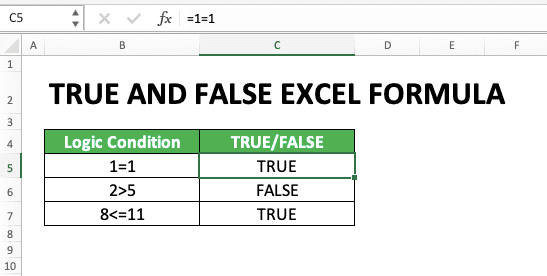How to Use TRUE and FALSE Formulas in Excel: Function, Example, and Writing
Home >> Excel Tutorials from Compute Expert >> Excel Formulas List >> How to Use TRUE and FALSE Formulas in Excel: Function, Example, and Writing
In this tutorial, you will learn how to use TRUE and FALSE formulas in excel. These two formulas will produce logic values that you can use for the data processing that needs to use it.
Disclaimer: This post may contain affiliate links from which we earn commission from qualifying purchases/actions at no additional cost for you. Learn more
Want to work faster and easier in Excel? Install and use Excel add-ins! Read this article to know the best Excel add-ins to use according to us!
Table of Contents:
- TRUE and FALSE formula function in excel
- Result
- Excel version in which TRUE and FALSE formulas can start to be used
- The way to write them and their inputs
- Example of usage and result
- Writing steps
- Alternative 1: write the logic value directly
- Alternative 2: use a logic condition
- Exercise
- Additional Note
TRUE and FALSE Formula Function in Excel
The usability/function of TRUE and FALSE formulas is to produce a TRUE or FALSE logic value in your cell/formula.Result
The result given by TRUE and FALSE formulas is a TRUE or FALSE logic value.Excel Version in Which TRUE and FALSE Formulas Can Start to Be Used
You can start to use these two formulas since excel 2003.The Way to Write Them and Their Input
Generally, the writing of TRUE and FALSE formulas in excel can be illustrated as follows.TRUE:
=TRUE()
FALSE:
=FALSE()
Simple, isn’t it? These TRUE and FALSE formulas don’t need any input. Just type them like in the illustration above, enter, and your logic values will be produced.
=UPPER(text)
As you can see above, the input needed by this formula writing is just one. It is text, the data you want to change all its letters into uppercase letters.
Example of Usage and Result
The following will give and explain the example of TRUE and FALSE formulas usage and result.TRUE:

FALSE:

As you can see from the examples, the way to use TRUE and FALSE formulas is pretty easy.
You just need to type TRUE/FALSE, an open bracket sign, and a close bracket sign. These two formulas don’t need any input so you just need to press enter after you type them. The logic value based on the formula you type will then be given to you.
The same thing also applies if you use a TRUE/FALSE formula in other formulas. You just need to type TRUE() or FALSE() to use their results as the other formulas’ input.
Writing Steps
The following will explain the steps to write TRUE and FALSE formulas. Each step will be explained with the help of an excel screenshot to make you learn it easier.TRUE:
-
Type an equal sign ( = ) in the cell where you want to put your TRUE logic value

-
Type TRUE (can be with large and small letters)

-
Input an open bracket sign, followed by a close bracket sign

- Press enter
-
Done!

FALSE:
-
Type an equal sign ( = ) in the cell where you want to put your TRUE logic value

-
Type TRUE (can be with large and small letters)

-
Input an open bracket sign, followed by a close bracket sign

- Press enter
-
Done!

Alternative 1: Write the Logic Value Directly
If you want, you can also get the same results as the TRUE and FALSE formulas through direct logic value typing. Type TRUE if you want a TRUE logic value and type FALSE if you want a FALSE logic value instead.See the examples below.
TRUE:

FALSE:

Excel will automatically convert the TRUE/FALSE text you type into a logic value data type.
Alternative 2: Use a Logic Condition
Want to get a logic value directly from a logic condition? You can do that also in excel.Just type an equal sign before your logic condition in the cell where you want to put the logic value. Excel will automatically evaluate the logic condition and give a TRUE/FALSE result, depending on whether the condition is right/wrong.
In the logic condition you input in excel, you usually need an operator. You use the operator as a connector and evaluator between the first and second values in your logic condition. The often-used operators in excel and their meaning are as follows.
| Operator | Meaning |
|---|---|
| = | Equal to |
| < | Less than |
| > | More than |
| <= | Less than or equal to |
| >= | More than or equal to |
The logic condition writing that can produce TRUE or FALSE in excel can be seen in the screenshot below.
TRUE:

FALSE:

Easy, isn’t it? You just need to type your logic condition in an excel formula format (with the equal sign in front of it). Press enter after you have done typing and the logic value from your logic condition evaluation will be produced.
Exercise
After learning how to use TRUE and FALSE formulas in excel completely, now let’s do an exercise.Download the exercise file and answer all the questions. Download the answer key file if you have done the exercise and want to check your answers. Or, probably, when you are confused about how to answer!
Link to the exercise file:
Download here
Questions
Answer each question in the gray-colored cell based on the number!- Is the logic condition number 1 TRUE or FALSE? Use the TRUE/FALSE formula to answer it!
- Is the logic condition number 2 TRUE or FALSE? Type a logic value text directly to answer it!
- Is the logic condition number 3 TRUE or FALSE? Type the logic condition in a formula format to answer it!
Link to the answer key file:
Download here
Additional Note
TRUE and FALSE formulas are compatibility formulas made available by excel to interact with other spreadsheet applications. We usually never use them in a normal data processing.Other formulas you need to learn too:














